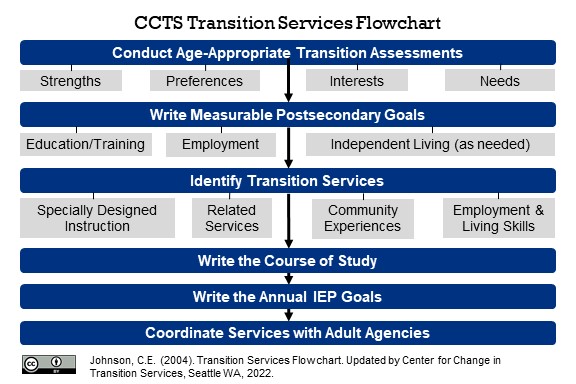Transition Services
Indicator B13 Transition Services Sequence and Flowchart
Transition Services and Indicator B13
Transition services are a set of coordinated activities designed to be a results-oriented process that facilitates the successful movement from school to postsecondary living. These activities are based on the student's strengths, preferences, interests, and needs.
Transition services include instruction, related services, community experiences, the development of employment and other post-school living objectives and, when appropriate, daily living skills.
IDEA (Individuals with Disabilities Education Act, 2004) Part B State Performance Plan (SPP) Indicator 13 is in place to measure the state's percent of youth aged 16-21 with an IEP that includes coordinated, measurable, annual IEP goals and transition services that will reasonably enable the child to meet the postsecondary goals.
Transition Services Flowchart
The CCTS Transition Services Flowchart describes the intentional flow of the Indicator B13 transition components. These components include age-appropriate transition assessments, writing postsecondary and annual goals, identifying transition services, writing the course of study, and coordinating services with adult agencies.

Download PDF:
Suggested Citation: Johnson, C. E. (2004). Transition Services Flowchart. Updated by Center for Change in Transition Services, Seattle, WA, 2022. CC BY 4.0.
Transition Services Training
View CCTS’s Writing Effective Transition Plans training course for details about the sequence and components of transition planning.
Indicator B13 Transition Components
Age-Appropriate Transition Assessments are the foundation for transition services. IEP teams collect student information from formal and informal assessments in the areas of strengths, preferences, interests, and needs.
For details, visit Module 2: Age-Appropriate Assessments from CCTS’s 10-part Writing Effective Transition Plans (WETP) training.
Measurable Postsecondary Goals must be included in student IEPs no later than age 16. Postsecondary goals are based upon age-appropriate transition assessments related to education/training, employment, and, when appropriate, independent living skills. These goals are reviewed annually.
For details, visit Module 3: Postsecondary Goals from CCTS’s 10-part Writing Effective Transition Plans (WETP) training.
Transition Services are a coordinated set of activities based on current age-appropriate transition assessments. These include instruction, related services, community experiences, and the development of employment and other post-school adult-living objectives. When appropriate, they also include the acquisition of daily living skills and the provision of functional vocational assessments.
For details, visit Module 4: Identify Transition Services from CCTS’s 10-part Writing Effective Transition Plans (WETP) training.
Course of Study is a current description of activities and classes the student will complete to achieve their desired postsecondary goals as described in the IEP.
For details, visit Module 5: Course of Study from CCTS’s 10-part Writing Effective Transition Plans (WETP) training.
Annual IEP Goals are statements that describe what students can reasonably be expected to accomplish within 12 months. These goals support the academic and functional skills necessary to achieve postsecondary goals.
For details, visit Module 6: Annual Goals from CCTS’s 10-part Writing Effective Transition Plans (WETP) training.
Adult Agencies can be invited to IEP transition planning meetings as appropriate and with student/family consent. These representatives can link students to services, accommodations, and support after high school.
For details, visit Module 7: Agency Connections from CCTS’s 10-part Writing Effective Transition Plans (WETP) training.
